Mastering Diamond Carat Weight Calculation

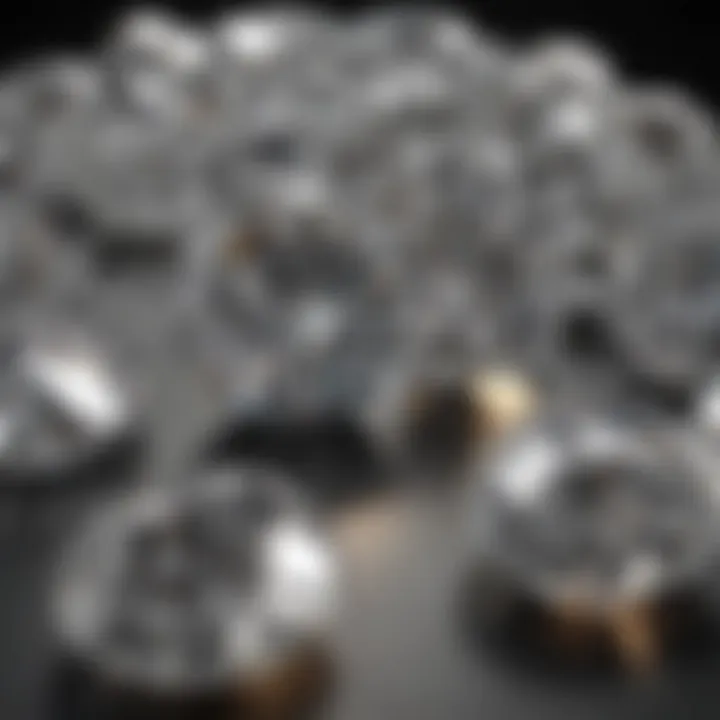
Intro
When we speak of diamonds, people often think about their sparkle and elegance; however, understanding the nuances of carat weight calculation is crucial. Especially for gemstone enthusiasts, jewelry designers, or anyone keen on the gemstone market, grasping this aspect can mean the difference between a wise investment and a costly mistake.
Diamonds aren't just mere rocks; they hold a wealth of potential in terms of aesthetic appeal and financial value. As we delve into the intricacies of diamond carat weight, it becomes clear how deeply intertwined this measurement is with the broader world of gems. To kick things off, let’s explore the fundamental aspects of gemstones.
Gemstone Overview
Definition of Gemstones
Gemstones are defined as precious or semi-precious stones that are cut and polished for use in jewelry. They possess beauty, durability, and rarity, making them highly sought after. What sets diamonds apart from other gemstones is not only their coveted brilliance but also the meticulous process involved in determining their carat weight.
Classification of Gemstones
Gemstones fall into different categories based on a variety of factors, such as composition and hardness. They generally classify into two main groups:
- Precious Gemstones: These include diamonds, rubies, sapphires, and emeralds. Their rarity and quality often lead to higher values.
- Semi-Precious Gemstones: This category encompasses a broader range of stones, such as amethyst, garnet, and aquamarine. While still beautiful, their lower rarity usually makes them less valuable.
Commonly used terms in the classification of gemstones also include the Mohs scale, which ranks mineral hardness. Diamonds, scoring a perfect 10, are notoriously resilient.
Historical Significance
Origins of Gemstone Use
The practice of adorning oneself with gemstones can be traced back thousands of years. Early utilizations were often imbued with cultural significance. Ancient peoples adorned themselves not only for beauty but also as symbols of power or protection.
Cultural Insights: Gemstones in Ancient Civilizations
In various societies, gemstones held deep cultural meanings. For example, in ancient Egypt, turquoise held a sacred status, while the Greeks associated sapphires with wisdom and royalty. The synchronization of beauty and meaning in gemstones often left them in high regard. Aspects like this continue to echo today, influencing our perceptions and valuation of these exquisite items.
"Throughout history, gemstones have been more than just aesthetics; they’re bridges to cultural narratives."
As we move forward in this article, we’ll delve deeper into the mechanics of diamond carat weight calculation—essential knowledge for navigating the gemstone market successfully.
Intro to Diamond Carat Weight
Understanding diamond carat weight is like knowing the pulse of the gemstone market. Carat weight plays a significant role in determining the value of diamonds and is a crucial factor for anyone interested in purchasing or selling these gems. In this section, we will delve into what carat weight genuinely means and why it is so important in the broader context of gemstones.
Knowing how carat weight is calculated not only equips buyers with necessary insights but also helps sellers price their stones correctly. A diamond's carat weight, though only one facet of its value, can sometimes overshadow other qualities, making it essential to grasp its implications. Whether you're a budding enthusiast or an experienced collector, understanding carat weight offers a foundation for making informed decisions in the intricate world of gemstones.
Definition of Carat Weight
Carat weight refers to the unit of weight used to measure gemstones, with one carat defined as 200 milligrams. The term "carat" has its roots in the carob seeds that were once used as balance scales in trade. As you might see, each diamond’s weight is gauge based on this measurement, and that's why when discussing diamonds, you'll often hear this term tossed around.
But it's crucial to note that carat weight doesn’t directly indicate size. Two diamonds of the same weight can appear noticeably different if their shapes or cuts are dissimilar. Therefore, when contemplating a purchase, one must consider both the carat weight and the stone's visual appeal.
It's an interesting paradox: a heavier stone is often assumed to be better simply because it’s heavier. However, it’s essential to keep an open mind about value, focusing on the overall quality rather than just the weight.
Importance in the Gemstone Market
Carat weight holds a prominent place in the gemstone market, influencing both pricing and desirability. In general, larger diamonds command higher prices, as scarcity plays a vital role in value determination. This market behavior can lead buyers into a peculiar trap; they may prioritize carat weight over other essential attributes like cut, clarity, or color.
In the gemstone world, there is often a hierarchy of the Cs—Carat, Cut, Clarity, and Color. Carat weight sits at the top of this list in terms of pricing, which makes it even more relevant for those navigating the market.
Understanding the subjective worth of carat weight can prevent missteps. For instance, during a diamond appraisal, focusing solely on carat weight might result in missing out on a diamond that offers better overall value because of its superior cut or clarity.
"In the world of diamonds, weight is important, but it’s just part of the picture."
As the market trends fluctuate, keeping abreast of how carat weight aligns with other factors is essential. For buyers, this means being educated, while sellers should remain transparent about their gemstones, ensuring any potential buyer knows what contributes to the value of the diamond beyond just the carats.
Carat weight is indispensable; understanding its implications gives both buyers and sellers an edge in the competitive gemstone landscape.
The Basics of Measuring Carat Weight
Understanding the fundamentals of measuring carat weight is essential for anyone involved in the diamond market. This section delves into the key elements of the carat system and the tools necessary for accurate measurement, ensuring that both buyers and sellers have a solid grasp of the intricacies involved. The precision in carat weight not only affects the pricing but also impacts the overall perception of value and quality in a diamond.


Understanding the Carat System
The carat is a unit of weight used to measure gemstones, and it stems from the traditional use of carob seeds in trading. One carat is equivalent to 200 milligrams, which may seem straightforward, but the implications of this measurement form a complex picture. The term 'carat' itself can often lead to confusion, as it connects to both weight and size. It’s commonly assumed that a larger diamond will automatically be more valuable based solely on weight, but this assumption can lead one astray.
In reality, two diamonds of equal carat weight can differ dramatically in their value due to factors like cut and clarity. Here are a few points to keep in mind:
- Weight vs. Size: A one-carat diamond can look different depending on its cut and shape. For example, a round brilliant cut will generally appear smaller than a cushion cut of the same weight due to its proportional dimensions.
- Price Tiering: The market tends to place heavier premiums on specific weights, especially at whole numbers like one carat and above. Knowing where these thresholds lie can aid buyers in making informed choices without falling into common traps.
Equipment Used for Measurement
Accurate measurement of carat weight not only requires understanding the concept but also necessitates the right tools. The following equipment is pivotal in ensuring a precise calculation:
- Jeweler's Scale: A high-precision scale specifically designed for weighing gemstones is crucial. These scales can measure weights down to fractions of a carat, ensuring that the smallest differences do not create discrepancies in value.
- Caliper: While not directly measuring carat weight, a caliper can be useful for determining the dimensions of a diamond. This is particularly relevant when assessing the size or cut quality of a diamond, which may indirectly tie back to its carat weight.
- Microscope: Understanding internal and external characteristics that might influence the perceptions of weight and value can also be critical. A microscope helps gemologists analyze flaws or inclusions that might affect a diamond's marketability.
Equipped with these tools, both sellers and buyers can perform precise calculations, helping them navigate the sometimes murky waters of diamond valuation.
"Precision in measurement is the cornerstone of fair valuation in the gemstone industry. Without it, both parties risk inequity in transactions."
Calculating Carat Weight
Calculating carat weight is a fundamental aspect of understanding diamond valuation. It isn't just about the numbers; it's about what those numbers represent in terms of beauty, rarity, and value. A diamond's carat weight often serves as a primary indicator for buyers, significantly influencing their purchasing decisions. Buyers need to grasp not only the basics of weight but also its implications. The higher the carat weight, the more substantial the diamond, which typically leads to higher pricing. However, factors like clarity, cut, and color also interlink with carat to create the overall value. As such, anyone interested in gemstones must appreciate and accurately calculate carat weight.
Mathematical Formulas Explained
The mathematical formulas behind carat weight calculation may seem straightforward at first glance, yet there's complexity beneath the surface. A carat is commonly defined as 200 milligrams. This means that to calculate the carat weight, you can simply divide the weight in grams by 0.2. For instance:
- If a diamond weighs 0.5 grams, its carat weight would be calculated as follows:[ Carat\ Weight = \fracWeight\ in\ grams0.2 = \frac0.50.2 = 2.5\ carats ]
It’s crucial to note that precision is key when weighing diamonds. A small scale capable of measuring to the nearest hundredth of a gram is recommended, as even minute discrepancies can impact perceived value. Consider standard measurement variances, such as how certain shapes may retain weight differently relative to size.
Additionally, with certain diamond shapes, using formulas that consider the diamond’s dimensions can be beneficial for more accurate assessments. For example, when dealing with round brilliant diamonds, the GIA provides specific formulas to calculate the volume based on measurements taken from the table to the culet. Knowledge of these formulas allows gemologists to provide true insights into a diamond’s carat weight, leading to a more honest and fair market.
Conversion from Other Weight Units
Converting carat weight from other weight units can not only enhance accuracy but also assist international buyers who may be accustomed to different systems. Here are some common conversions:
- Grams to Carats: Since 1 carat equals 0.2 grams, you multiply the weight in grams by 5 to find the carat weight. For example, a diamond weighing 1 gram is 5 carats.
- Milligrams to Carats: It’s 1 carat for 200 milligrams, meaning you can divide the weight in milligrams by 200 to calculate carat weight.
- Ounces to Carats: There are 7,054.8 carats in one ounce, so the conversion involves multiplying the ounce weight by 7,054.8.
In navigating these conversions, being precise becomes paramount, especially for investors and collectors who might deal with different international measurements. A slip in conversion can drastically alter perceptions of worth.
"Understanding weight measurements correctly not only helps to build confidence as a buyer but also ensures that you get what you pay for in the gem market."
In a field rife with nuance and detail, familiarizing oneself with such calculations is not merely useful but essential. By mastering carat weight, buyers can avoid pitfalls and make informed decisions that align with their desires.
For deeper insights, you can visit Wikipedia or explore articles on Britannica.
Factors Affecting Diamond Value
When it comes to figuring out how much a diamond is worth, it’s not merely about the carat weight, though that plays a significant role. Understanding what factors influence diamond value can help both buyers and sellers navigate this intricate market. In essence, the diamond’s value is a puzzle, with various pieces coming together to form a complete picture.
The 4Cs of Weight and Value
The framework for assessing diamond value revolves around the well-known 4Cs: Carat, Cut, Color, and Clarity. This system serves as a foundation for understanding how weight correlates with value:
- Carat: This directly refers to the weight of a diamond. Larger diamonds are typically rarer and therefore more valuable. However, weight alone doesn’t dictate worth.
- Cut: A diamond's cut affects its brilliance and fire. A well-cut diamond reflects light beautifully, increasing its perceived value. If cut poorly, even a large, high-carat stone may not impress.
- Color: Diamonds are graded on a scale from D (colorless) to Z (light yellow or brown). Generally, colorless stones are more sought after, raising their market value.
- Clarity: This refers to the presence of internal or external flaws, known as inclusions and blemishes. The fewer flaws, the higher the clarity grade, which translates into higher value.
These four characteristics are interdependent. A diamond may have a significant carat weight, but if it’s poorly cut or has low clarity, its market value might be disappointing compared to a smaller stone with an excellent cut and clarity.
Market Trends and Their Impacts
Market trends play a substantial role in diamond value as well. Just like the stock market, diamond prices can fluctuate based on a host of factors:
- Supply and Demand: An increase in supply, for instance, can lead to a decrease in prices, while a surge in demand can push prices higher.
- Economic Conditions: When the economy is booming, more people are willing to invest in luxury items like diamonds. Conversely, during recessions, interest may wane, affecting prices.
- Fashion Trends: Preferences in jewelry styles can sway the desirability of certain diamonds. A trend towards vintage or colored diamonds can elevate prices in those categories, while round-brilliant cuts might drop in popularity.
- Cultural Influences: Cultural events, holidays, or special occasions (like engagements) create peaks in demand. For instance, the festive season typically sees a spike in diamond purchases.
In summary, while the 4Cs provide a structured framework for evaluating diamonds, understanding market trends is equally essential for both buyers and sellers. Keeping an eye on these shifting tides can inform better purchase decisions or sales strategies.
Challenges in Carat Weight Calculation
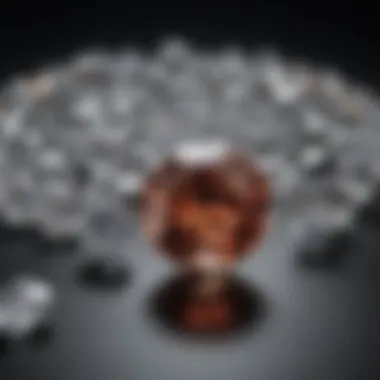
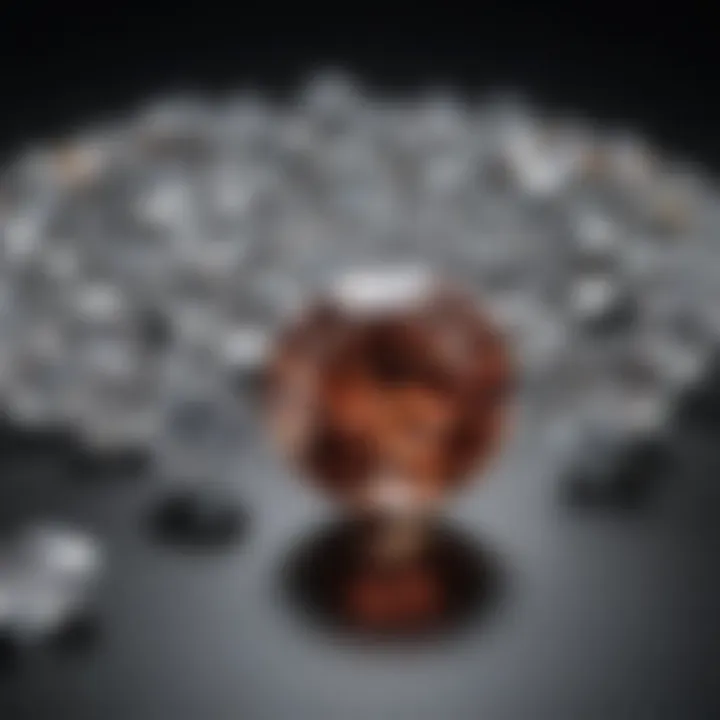
Understanding the challenges that come with calculating carat weight is essential for anyone interested in gemstones. It’s not just about weighing a diamond and calling it a day; various factors can complicate what might initially seem straightforward.
Variations in Diamond Shapes
When it comes to diamonds, not all shapes are created equal. Different cuts can affect how weight is perceived. For instance, a round diamond often looks larger than a pear-shaped one of the same carat weight. This illusion can be deceiving for buyers.
Moreover, the unique geometry of each shape leads to variations in mass distribution. This means that two diamonds of equal carat weight may have different appearances based purely on their shape. For example:
- Round Brilliant Cut: Often maximizes sparkle but can challenge weight accuracy due to its proportions.
- Princess Cut: Takes more rough material to create, which can affect how weight is calculated.
Dealers and buyers need to be aware of these variations as they directly impact valuation. Understanding how a diamond's shape influences its appearance and perception becomes crucial, especially when weighing size against value.
The Role of Clarity and Cut
Clarity and cut significantly influence carat weight calculation. A diamond with high clarity can weigh the same as a lower clarity diamond but can appear different when looked at under light. Factors like inclusions and blemishes can affect a diamond’s brilliance and visual appeal. For instance, a diamond with small inclusions might weigh just as much but not reflect light the same way a flawless diamond would.
Furthermore, the cut of the diamond is pivotal in how it presents itself, even with equal carat weights.
- Ideal Cut: Maximizes light return and sparkle, often making a smaller diamond appear larger.
- Poor Cut: May weigh similar but lacks brilliance, thus not providing the same value.
These elements add layers of complexity to calculating a diamond's actual value based on carat weight. Discerning buyers should pay attention to how a diamond’s cut impacts not only its weight but also its overall aesthetic and market value.
"A diamond's worth is not simply in its weight, but how that weight presents itself through clarity and cut."
Understanding these challenges enables gem enthusiasts and buyers to make informed decisions. It instills knowledge that goes beyond superficial measurements. Taking time to consider how these factors intertwine with carat weight can ultimately lead to more satisfactory purchases.
Practical Tips for Buyers
When stepping into the world of diamonds, understanding carat weight is just the tip of the iceberg. Practical tips for buyers not only enhance knowledge but also empower informed decisions. Knowing what to look for can make the diamond-buying experience far less daunting. Often, buyers assume that heavier stones automatically translate to better quality, but the truth is more nuanced. Here, we dive into essential tips to help navigate through the complexities of carat weight and ensure you’re making a sound investment.
Assessing Carat Weight Before Purchase
Before you even step foot in a jewelry store, it’s crucial to have a good grasp of what carat weight means to you. Start by asking yourself:
- What’s your budget? Carat weight heavily influences price.
- Are you looking for something small and delicate or a bold statement piece?
- Is it for daily wear or a special occasion?
Having these considerations in mind helps you determine an appropriate carat weight. Remember, a one-carat diamond weighs 200 milligrams, and weights above that will dramatically increase in price. For instance, a 1.5-carat diamond usually costs significantly more than a 1-carat stone due to the rarity of larger stones.
Once you're shopping, request the specifics on carat weight from the jeweler. Read the certificate when available, as it provides crucial data about the diamond’s attributes. This will help you to visualize size relative to quality—there’s no point in focusing solely on larger stones that don’t meet your aesthetic preferences or investment goals.
Avoiding Common Pitfalls
Navigating the diamond market can feel like walking through a minefield, particularly when carat weight is involved. To help you avoid common pitfalls, keep these key points in mind:
- Overemphasis on Size: A common mistake is compromising other qualities like clarity and cut in favor of a larger carat weight. Remember, a smaller diamond might sparkle far more brilliantly than a larger but poorly cut counterpart.
- Ignoring Certification: In the diamond world, certification is your safety net. Don’t skip this step; always ask for a grading report from recognized organizations like the Gemological Institute of America (GIA) or the American Gem Society (AGS).
- Setting a Fixed Weight: Being too rigid with a specific carat weight can limit your options. You might find that a 0.98-carat diamond has a dramatic appearance compared to a 1.01-carat stone. Focus instead on how the diamond fits your overall design and intention.
"Remember, it’s not merely about carat weight; it’s about the entire experience and value you receive. "
- Price Comparisons: While the diamond trade is unique, comparing diamond prices by carat weight can be tricky. Ensure you’re comparing similar quality stones to get an accurate measure of value.
Adopting these practices will not only enhance your purchasing power but also provide peace of mind during your diamond-buying journey. The wisdom drawn from these practical tips serves to enhance your understanding of what truly matters when investing in diamonds.
The Role of Technology in Measurement
In the realm of diamond valuation, the significance of technology cannot be overstated. The complexities involved in accurately calculating carat weight have necessitated the advancement of modern tools and techniques, which have become indispensable in the gemstone market. Technology serves not only to simplify the process but also to enhance the precision of measurements, ultimately affecting the value assigned to each diamond.
With diamonds being coveted for both their beauty and rarity, every fraction of a carat counts. Thus, leveraging cutting-edge technology directly translates into better valuation, leading to informed purchasing decisions, whether for personal adornment or investment. Furthermore, as demand rises and consumers become more discerning, the role of technology is increasingly pivotal in maintaining market integrity and value.
Modern Tools and Techniques
Today, the equipment at a gemologist's disposal has evolved significantly. Gone are the days when weighing diamonds was solely reliant on manual scales. Now, laser technology and digital measurement devices are revolutionizing this space.
- Digital Scales: Precision is vastly improved with digital scales that can measure carat weight to the nearest one-hundredth of a carat. This level of accuracy is critical for distinguishing between similar gems and can significantly influence their market value.
- 3D Scanning Software: Techniques employing 3D scanning allow for complete profiling of diamond shapes, enabling gemologists to take into account variations that can affect perceived weight and value. Such software generates detailed images, which help assess the diamond's cut quality and aesthetic appeal.
- Weight Estimation Apps: With the rise of applications, estimating diamond weight from measurements of its dimensions has become easier. These apps use algorithms to determine approximate carat weight based on length, width, and depth, providing a quick reference point for buyers and sellers alike.
This technological leap gives buyers greater confidence in their purchases, knowing they are backed by precise data rather than mere estimations.
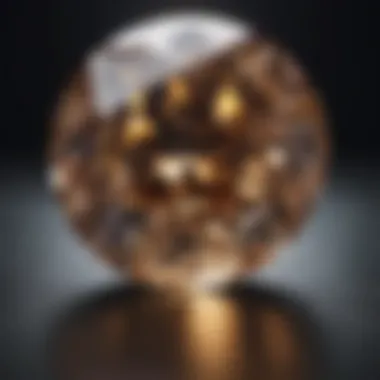
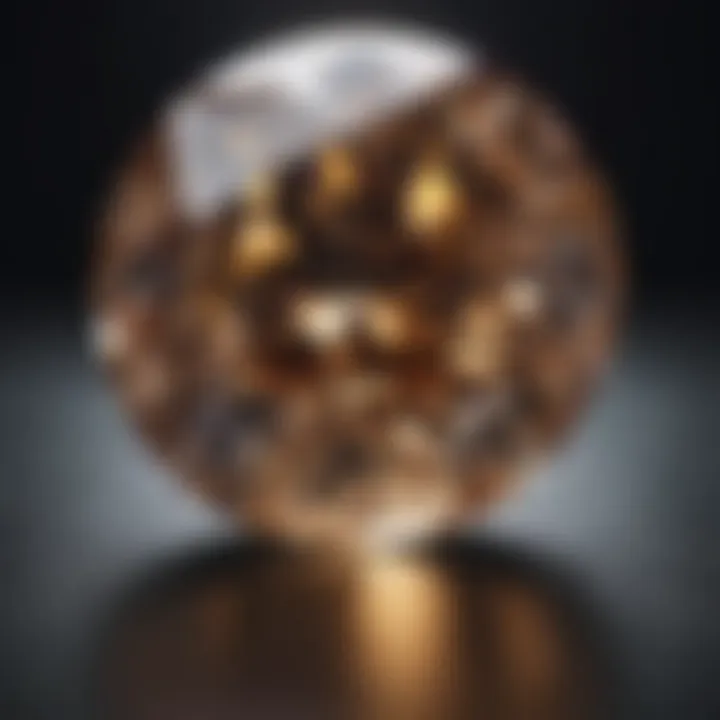
Future Trends in Carat Weight Assessment
Looking ahead, the landscape of diamond carat weight assessment is poised for even greater refinement with anticipated technological advancements. As we pace into an era where artificial intelligence and machine learning are coming to the forefront, these innovations will likely reshape how we measure and value diamonds.
- AI-Driven Valuation Algorithms: As machine learning algorithms become more sophisticated, they may revolutionize how diamonds are assessed. These algorithms could analyze a multi-dimensional data set of diamonds, considering not just carat weight but also cut, clarity, and color to suggest real-time valuations, thereby providing a holistic view.
- Remote Measurement Tools: The rise of virtual consultations and online marketplaces calls for tools that facilitate measurements without needing the physical presence of the gem. Technologies that allow for remote verification and assessment will provide customers broader access and transparency.
"Technology in gemstone measurement is not just about precision; it's about democratizing access to quality and information for all buyers."
- Augmented Reality (AR) Applications: As AR technology develops, tools that allow prospective buyers to visualize diamonds in real-time through their smartphones could enhance the purchasing experience. Imagine being able to see how a diamond looks on your finger without stepping into a store.
Case Studies in Carat Weight Calculation
Case studies in carat weight calculation are invaluable for understanding how various factors influence gemstone valuation and buyer perception. They provide concrete, real-world examples that illustrate the intricacies involved in determining the worth of diamonds based on their carat weight. Not only do these case studies shed light on the practical applications of theoretical concepts, but they also highlight common pitfalls and best practices that both buyers and sellers should be aware of. Through these examples, one can see how diverse aspects like cut, clarity, and market demand interplay with carat weight to determine value.
Examples of Gemstone Valuation
To grasp the real impact of carat weight on a diamond's value, consider this example: A round brilliant cut diamond weighing 1.0 carat with high clarity and color grading can command a significantly higher price compared to a 1.0 carat diamond of lower qualities. For instance, a diamond like a GIA-certified D-color, VVS1 clarity round diamond of one carat may sell for upwards of $10,000, whereas a similar 1.0 carat diamond with I-color and SI2 clarity might be priced around $3,000.
This discrepancy clearly shows that while carat weight forms the basic framework of valuation, other attributes can tip the scales dramatically. Buyers must analyze these details closely; sometimes, it is not just about having a larger diamond but also about having one that aligns with desirable quality parameters. Most knowledgeable buyers would rather choose a smaller diamond with higher quality than a larger one that falls short on clarity or color.
Comparative Analysis of Different Diamonds
When examining variations among diamonds, conducting a comparative analysis often reveals startling insights. For instance, consider three diamonds that are all 2.0 carats: one is an emerald cut, the second is a pear shape, and the third is an antique brilliant cut. While all weigh the same, their appearance, brilliance, and pricing can differ immensely based on cut styles, which directly influences perceived size and sparkle.
- Emerald Cut: 2.0 carat; price: $15,000
- Pear Shape: 2.0 carat; price: $18,000
- Antique Brilliant Cut: 2.0 carat; price: $12,000
This example illustrates the importance of understanding that different cuts can lead to varying demands and ultimately affect pricing in the market. A diamond's shape can change how light interacts with it, which can enhance or dull its brilliance. Buyers should keep an eye on these distinctions not just to avoid overspending but also to ensure they are making a well-informed, thoughtful investment into something that carries both emotional and monetary weight.
"The value of a diamond is several times more than its weight when assessed through a lens that considers clarity and cut—these stones are not just measured by carat, but by the artistry that shapes them too."
Understanding the broad spectrum of diamond valuation and carat weight calculation through real-life cases allows gemstone enthusiasts to deepen their knowledge, thus honing their skills whether they are collecting, purchasing, or designing jewelry pieces.
The End
Navigating the complexities of diamond carat weight calculation is not just a quest for knowledge but an essential exercise for anyone who engages with gemstones. Understanding how carat weight impacts value can significantly enhance both purchases and sales. It fosters informed decision-making that benefits buyers and sellers alike, allowing them to navigate the diamond market with confidence.
Recap of Key Points
To recap, the key points discussed throughout this article include:
- Definition and Significance: Carat weight serves as a universal measurement for gemstones, directly impacting perceived value and desirability.
- Measurement Techniques: Various methods and tools are employed to ensure precise calculations of carat weight.
- Factors Influencing Value: Beyond weight, factors like clarity, cut, and market trends play pivotal roles in determining overall gemstone value.
- Practical Guidelines: Essential tips for buyers regarding assessment and avoiding pitfalls ensure smoother transactions.
- Technology's Role: Technological advancements are reshaping how carat weight is assessed, making the process more accurate and accessible.
The Future of Diamond Valuation
Looking ahead, the landscape of diamond valuation is set for transformation. Technological integration—from sophisticated measurement tools to blockchain for authenticity—will likely set new benchmarks in transparency and trust within the gemstone market.
Furthermore, changing consumer preferences towards ethically sourced gemstones may also influence how diamonds are valued in the years to come. The industry must adapt to maintain relevance and meet the demands of a more informed and conscientious buyer base.
Further Reading and Resources
When diving deeper into the world of diamonds, especially regarding carat weight, it's vital to have access to trustworthy sources. This section elucidates the significance of further reading and resources, as they provide comprehensive insights and enhance one’s understanding of gemstone valuation.
Exploring various materials—be it books, articles, or online platforms—can empower both buyers and sellers. Knowledge truly is power in the gemstone market. By consulting these resources, one can gain a nuanced grasp of carat weight calculation and its impact on value, ensuring informed purchase decisions.
Ungathered knowledge could translate to missed opportunities or unfavorable deals. Leveraging the right resources allows enthusiasts to navigate the nuanced terrain of diamond valuation with greater ease. Moreover, it encourages a more experienced approach to assessing diamonds in relation to their carat weight and overall worth.
"A little learning is a dangerous thing; drink deep, or taste not the Pierian spring."
Books on Gemstone Valuation
Books act as fundamental pillars for serious gemstone enthusiasts. They provide structured learning and offer deep dives into complex subjects like carat weight and valuation. Some notable titles include:
- "Gemstones of the World" by Walter Schumann
This book presents a comprehensive overview of various gemstones, including extensive sections on diamonds. - "Gem Identification Made Easy" by Keith & Carolyn Cecil
Here, readers can learn about the identification and valuation of diamonds and other gems, providing valuable context for understanding carat weight. - "The Handbook of Gemmology" by Ronny Wurtzburger
This serves as an in-depth guide, breaking down the intricacies of gemstones and offering insights into valuation methods.
These books not only provide technical information but also offer personal anecdotes from the authors, creating an engaging learning experience. Additionally, the illustrations and diagrams found in such texts can greatly aid in comprehending complicated concepts.
Online Platforms for Gemstone Education
In today's fast-paced digital world, the internet has become a treasure trove of resources for gemstone education. Various online platforms cater to different learning styles, and they are accessible anytime. Here are some worth exploring:
- Wikipedia
A great starting point for understanding basic concepts in gemology, including carat weight. It offers summaries that can lead to more in-depth research. - Britannica
Providing articles that are usually well-researched and reliable, allowing learners to expand their knowledge base with credible information. - Gemology Reddit Community
This platform allows for engaging discussions, where enthusiasts can pose questions and share insights about carat weight calculations and their implications. - Facebook Groups on Gemstones
Engaging with niche communities can lead to valuable information sharing. Many groups are dedicated to gemstones, which share firsthand experiences and tips.
These platforms help not only with academic understanding but also with practical, real-world applications of gemstone valuation principles. They foster community learning, making knowledge more approachable and engaging.



